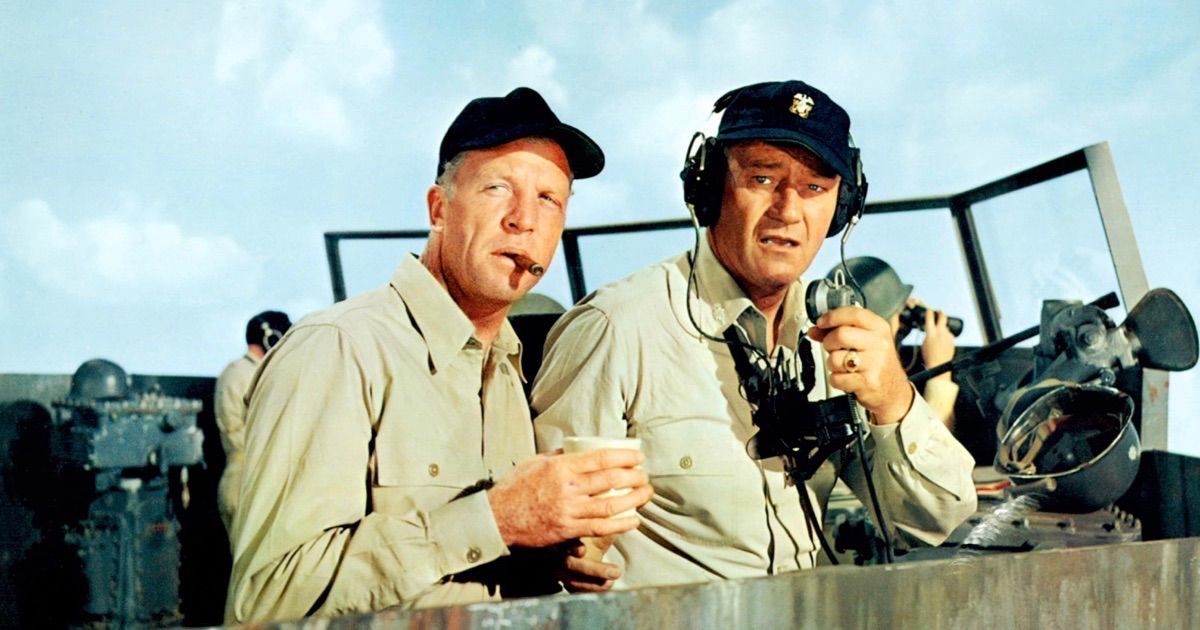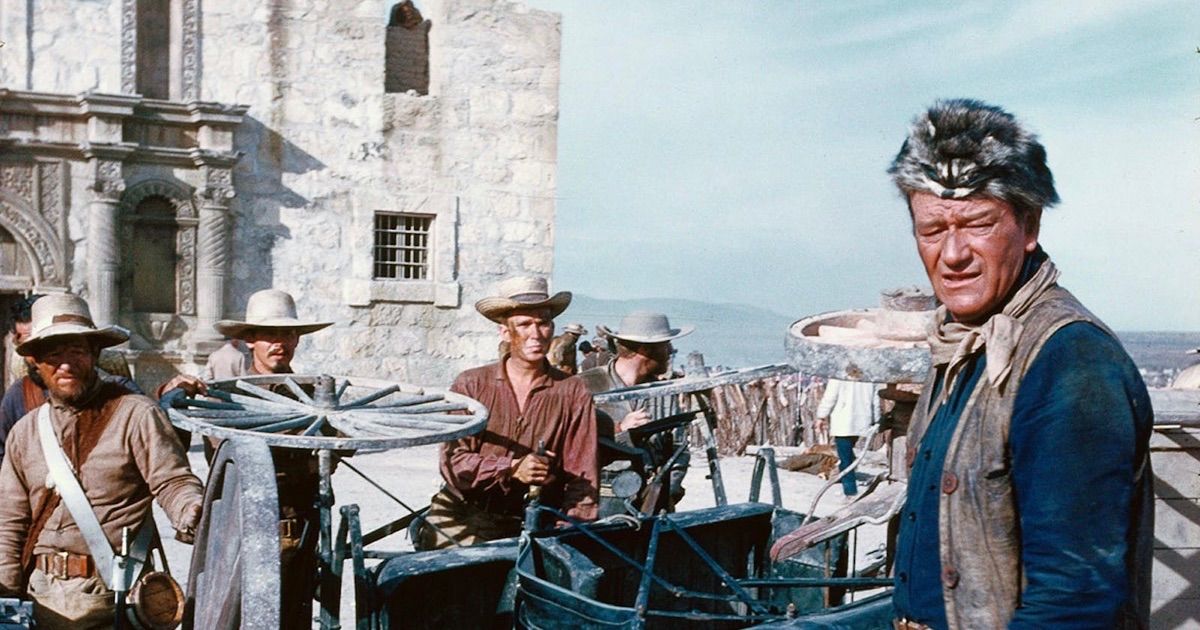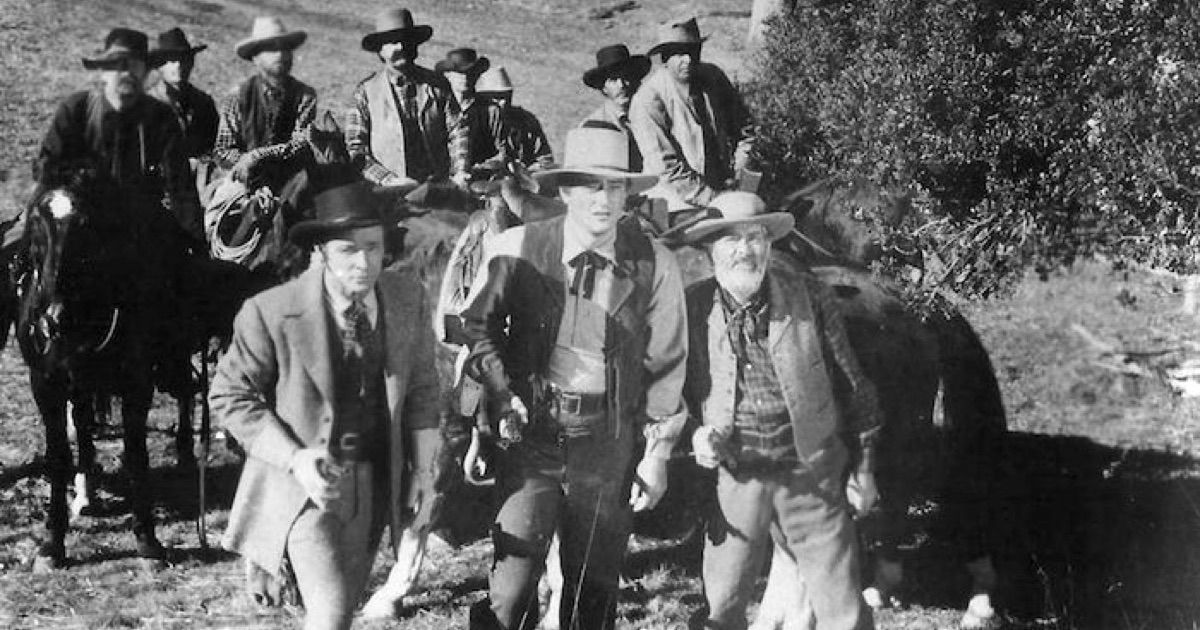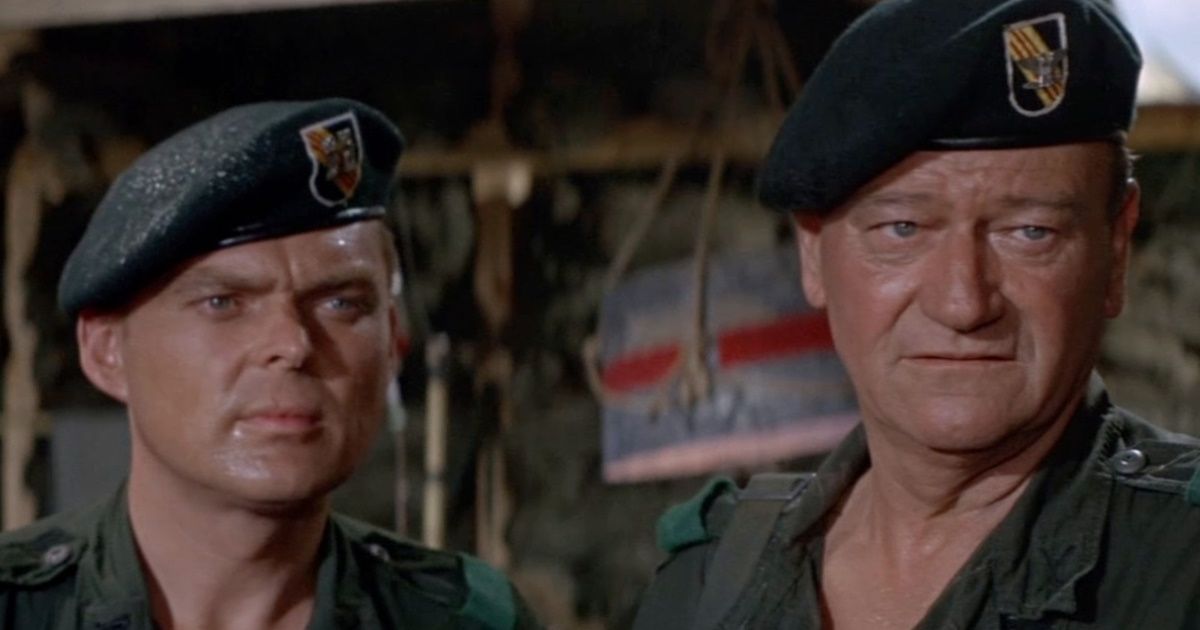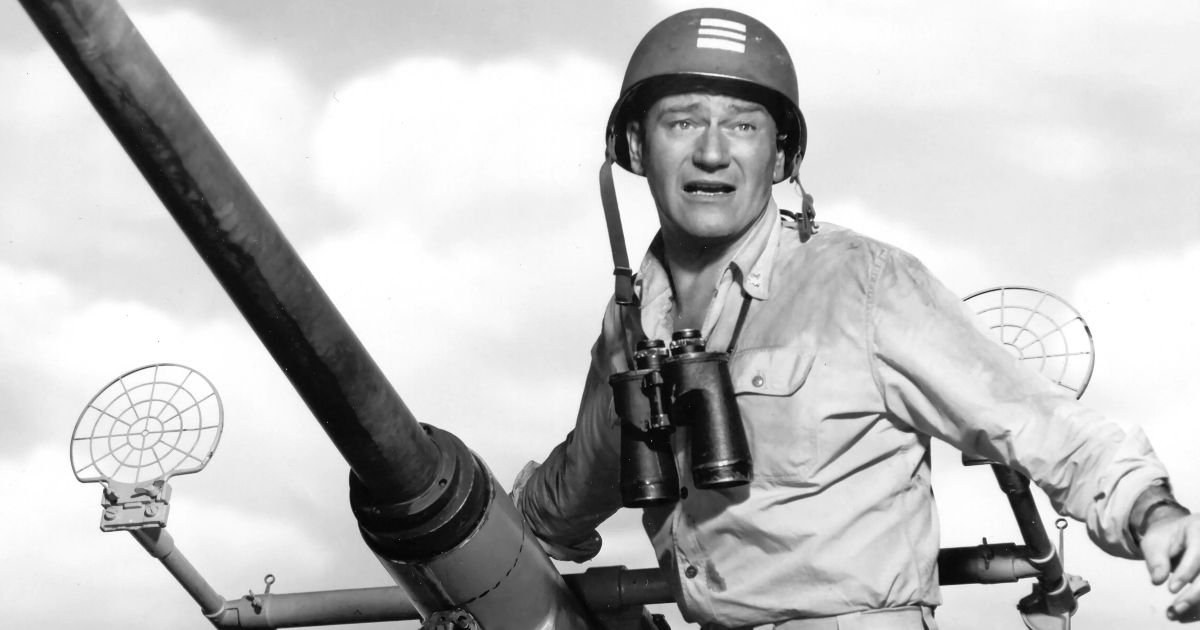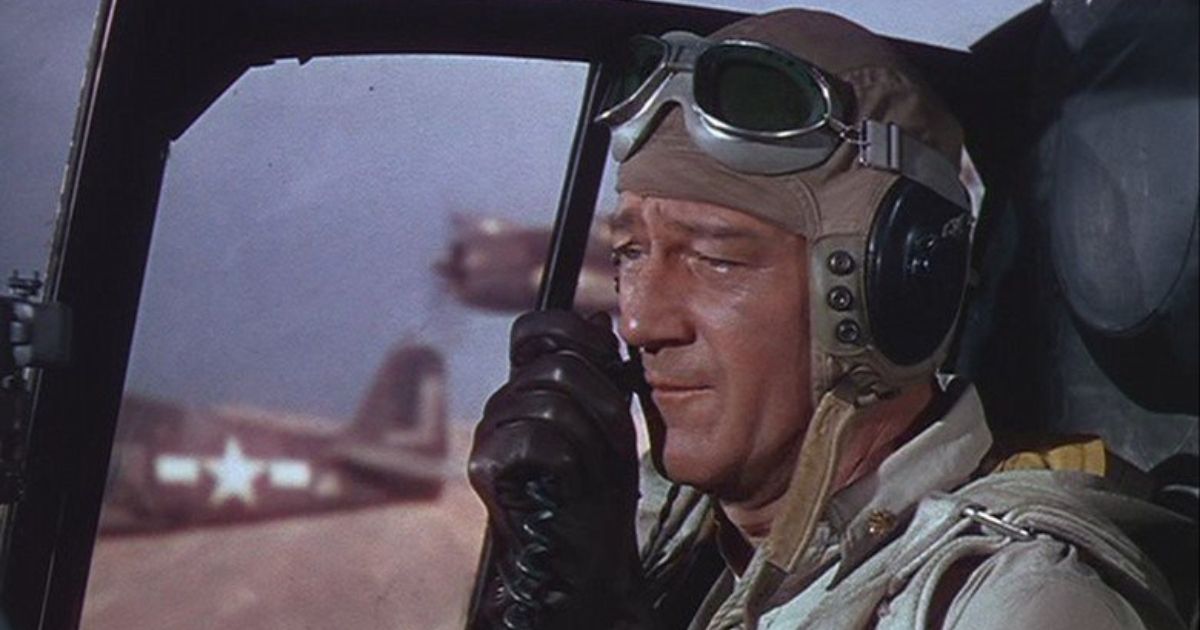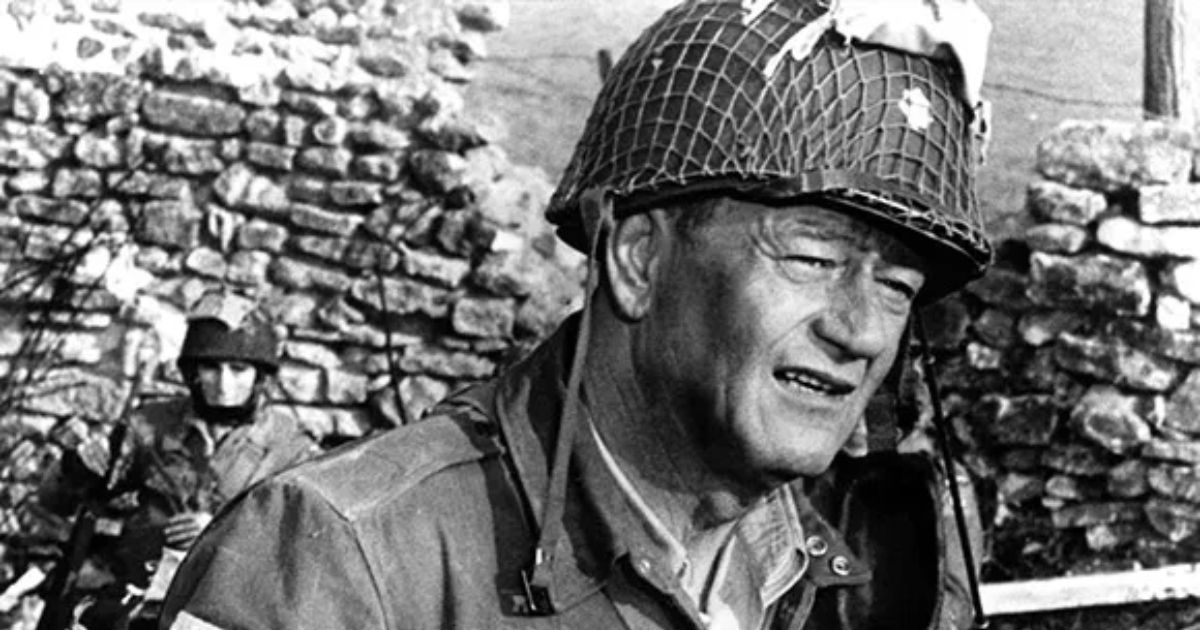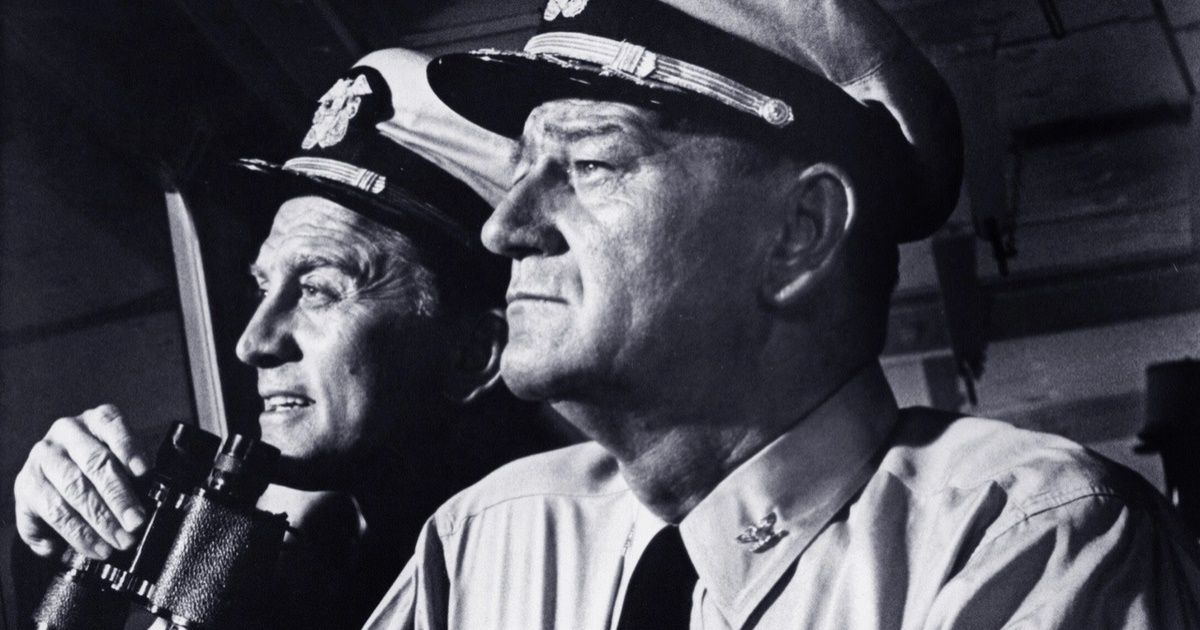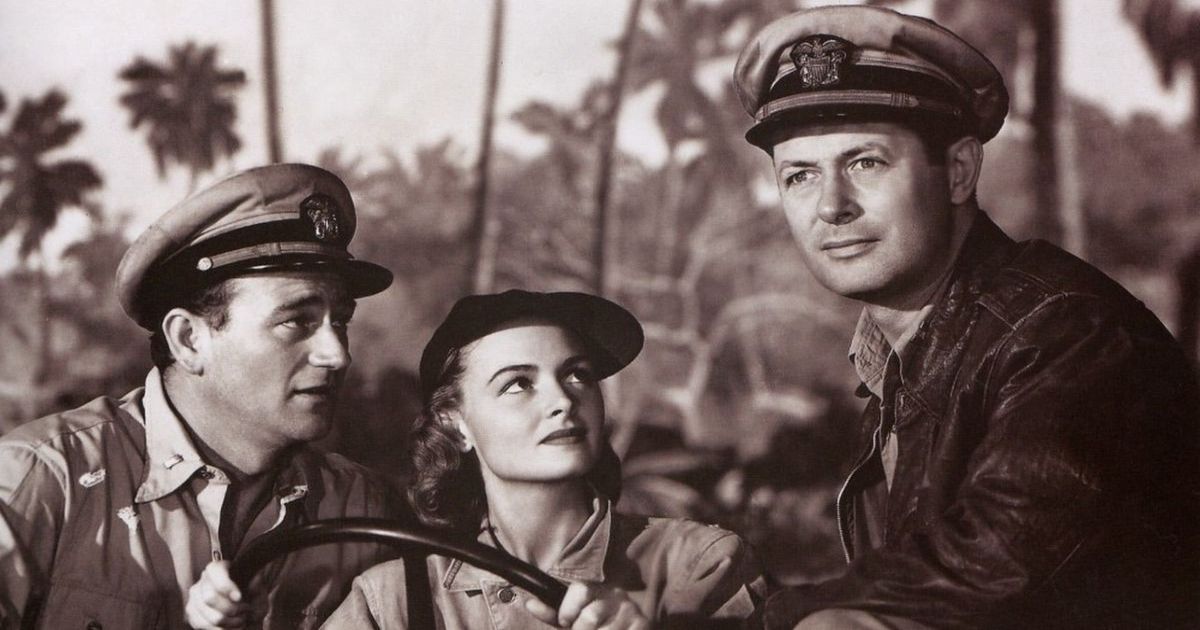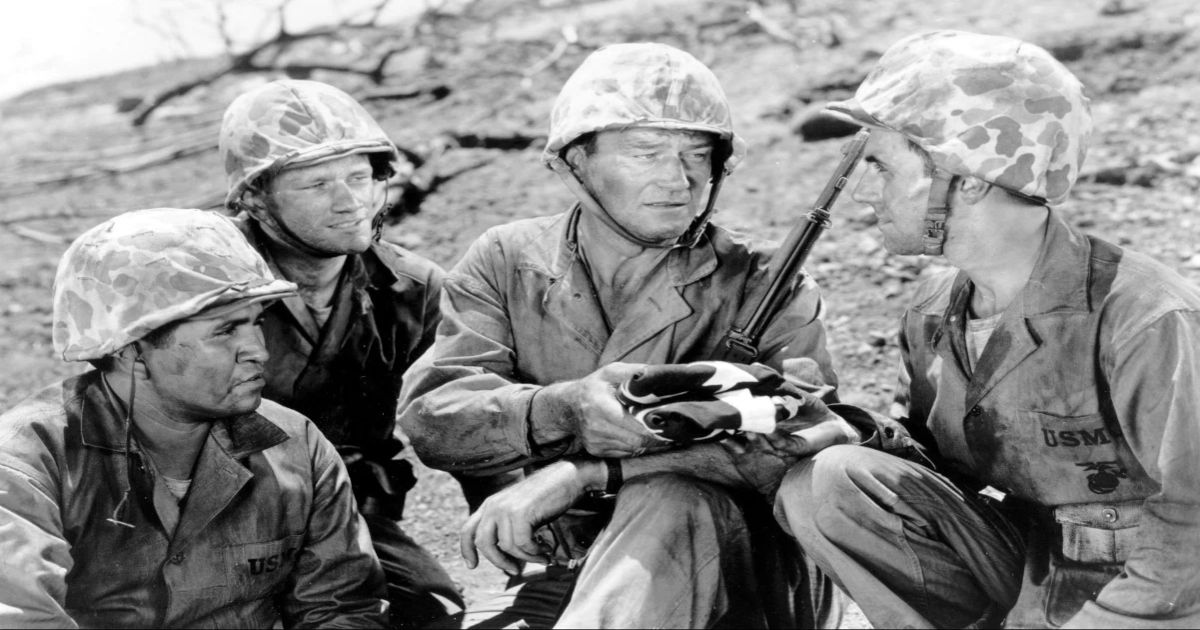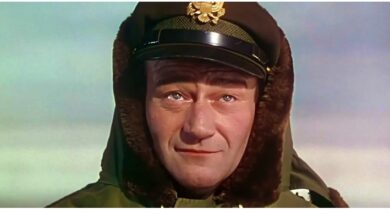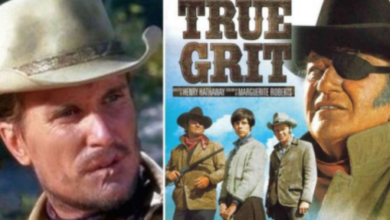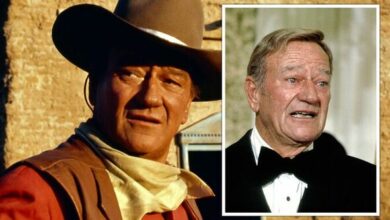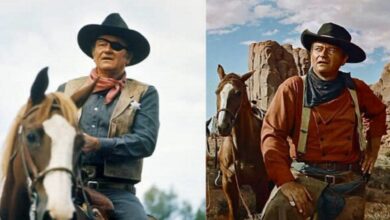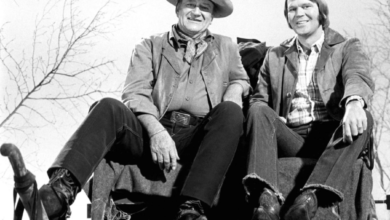John Wayne’s Best War Movies, Ranked
While John Wayne may be primarily known for his Western movies, the patriotic actor made sure to star in many war films, and these are the best.

John Wayne is a Hollywood icon with a presence so dominating, he defined two different American film genres: Westerns and war films. While Hollywood’s golden age may have produced better actors, few approached the charisma or screen presence of Wayne, who was the embodiment of America and masculinity on movie and television screens for nearly half a century.
Born Marion Robert Morrison in Iowa in 1907, Wayne broke into films in 1926, playing an uncredited football player in Brown of Harvard. He spent more than a decade in dozens of B-movies, mostly Westerns, until director John Ford made Wayne a star in 1939 with the lead role in the classic western Stagecoach. In 1976, exactly 50 years after his movie debut, Wayne starred in his last film, The Shootist, and died in 1979 of complications from cancer.
Of the more than 150 films Wayne made in his career, just over a dozen of them are non-western war films. Yet, he remains a war movie icon, because most of those films were box office hits and classic movies that still stand out more than 40 years after his death. Let’s take a look at the 10 best war films from The Duke, with many available to stream online or purchase on physical discs.
Updated on July 31st, 2023 by Hanumanth: This article has been updated with additional content to keep the discussion fresh and relevant with even more information and new entries.
15The Wings of Eagles (1957)
The Wings of Eagles may seem like another classic from the combination of John Ford and John Wayne, two pioneers of Western and War genres, but it is much more than that. Even if John Ford had not taken up this biographical war film, Frank W. ‘Spig’ Wead, the personality behind the story, would still go down in history as one of the most passionate writers of military-oriented stories.
The late Frank W. “Spig” Wead was an ardent U.S. Navy pilot who admired his work so much that he didn’t give up even after getting paralyzed due to an accident. Instead, he found a new means to express his love for aviation through screenwriting. After gaining a promotion in naval aviation through pen and screen, he realized that the need for the greater good takes precedence over personal happiness. In some ways, the story is both tragic and moving, and with Wayne’s authentic portrayal of Wead’s life, it remains one of his best war films to date.
14The Alamo (1960)
The Alamo, produced and directed by John Wayne, is a timeless classic that touches on both Western and War themes, depicting the lopsided battle for Texas freedom in 1836. This fourteen-year-in-the-making twelve-million dollar epic is apparently loved for many reasons, but the presence of John Wayne always takes precedence since it was heavily self-indulgent with endless scenes of The Duke’s trademark elements like getting drunk with his pals and punching each another for fun.
However, the film picks up the pace in the second half with non-stop battles between the resistance and the tyrannical army. The story sheds light on the heroic last-ditch efforts of Texas resistance soldiers led by General Sam Houston against the massive Mexican army commanded by Santa Anna. The resulting carnage and sacrifices made by the fighters for a better future are flawlessly depicted in the film, making it a must-see.
13Reunion in France (1942)
Reunion in France is an exception on the list as John Wayne is not the main focus of the story but definitely plays a significant role in driving the story forward. In the movie, Joan Crawford plays Michele, a stunning and wealthy woman who does not believe that Germany would occupy France under Hitler’s reign until her vacation gets ruined when she comes to realize that her husband, Robert (Philip Dorn), is working with Nazis.
Enter Pat Tablot (John Wayne), an American pilot who is helped by Michele in hiding from both the Nazis and her suspicious husband. The basic setup of the movie indicates that it is a war film at the core, but it also emphasizes romance to provide a means to enjoy it in both forms. Nonetheless, the movie is surprisingly full of plot twists and turns, with some great performances from the main cast, who keep the story moving forward without pause.
12How the West Was Won (1962)
This epic Western film, How the West Was Won, is set against the backdrop of battles and historical events, depicting the sprawling saga of a family with gorgeous visuals and scenarios all around. While some find the movie to be one of Ford’s distinctive works based on the drama of the Western setting, others believe it was a film put together with the intention of assembling a once-in-a-lifetime cast with big names like John Wayne, James Stewart, Henry Fonda, Caroll Baker, and Gregory Peck.
The film, set in the 1830s, covers the Westward expansion of the Prescott family and how these migrants were entangled in the impending Civil War for generations. Although the film was not entirely Wayne-focused, he had such a strong presence despite it featuring a large number of talented actors.
11Dark Command (1940)
One year after Stagecoach, which was one of the best Westerns that set things in motion for John Wayne’s career, he would go on to star in his first “A” film at Republic, carried by a strong cast including Walter Pidgeon, Claire Trevor, and Roy Rogers. The film, set in the pre-Civil War period, depicts the battle between Northerners and Southerners who were trying to settle in Kansas and revolves around a Texas cowboy named Bob Seton (Wayne), who inadvertently gets into conflict with Will Cantrell (Pidgeon), a local schoolteacher with lofty ambitions.
When Bob wins both Will’s dream job as Marshall and the Southern banker’s daughter, Miss Mary McCloud (Trevor), the latter decides to exploit the power of lawlessness to achieve his goals, even if it means ravaging the entire settlements by sparking a war between them. Dark Command is part Western, part Civil War, but it is undeniably one of John Wayne’s best films, which steered him on the right course of his career.
10The Green Berets (1968)
One of Wayne’s most controversial films, The Green Berets was The Duke’s attempt to single-handedly change public opinion about the Vietnam War. Unfortunately, Wayne took the same narrative approach to Vietnam as he did with his World War II films, and that didn’t fly in an America where public opinion had already soured on the war, following the Tet Offensive and news of war atrocities. Wayne, who co-directed the film, took a heavy-handed patriotic approach to the story, but critics ravaged the film for his attempt to take the moral high ground.
In retrospect, The Green Berets may have been judged too harshly, as it is a solid Vietnam War film. While it glossed over the harsher realities and misdeeds of American soldiers (not to mention the ineptitude in Washington), it rightly focused on Viet Cong atrocities against civilians and the effort to stop Russian and Chinese Communist expansion into Southeast Asia. That means the film preaches far too much about the need for American intervention, but the actual battle scenes make the film worthwhile. Considering it was made in the midst of the war, we can forgive the unrealistic combat techniques and the fact that the Georgia forests (where it was filmed) didn’t resemble Vietnam at all.
9Operation Pacific (1951)
Operation Pacific by The Wolf Man director George Waggner, finds John Wayne playing the XO of an American submarine when tragedy strikes the crew. Racked with guilt, Wayne must pull it together when faced with a dangerous mission against the Japanese.
The film may not be the most realistic submarine movie ever, but it’s entertaining, as Wayne and his good friend Ward Bond (who plays the sub captain) have great chemistry. The two made 23 films together, including The Searchers and The Quiet Man, and they are joined by Patricia Neal as Wayne’s love interest in the film. Critics didn’t care for the film, but it’s a corny crowd-pleaser that’s still worth a watch.
8Flying Leathernecks (1951)
Wayne and frequent co-star Robert Ryan (The Dirty Dozen) play Marine aviators in Flying Leathernecks, and their dynamic gives the film an interesting angle. Wayne plays Major Daniel Kirby, who is trying to whip his squadron pilots into shape as they prepare for battle in the Pacific. Ryan plays Capt. Carl Griffin, Kirby’s soft-hearted second-in-command, who plays good cop to Kirby’s bad cop. Their clash of personalities has consequences, and the pilots learn the real cost of going into battle unprepared.
The film is one of two John Wayne films produced by Howard Hughes’ production company, with the other being Jet Pilot, highlighting Hughes’ fascination with aviation. In the age of Top Gun: Maverick, the cockpit shots (obviously filmed on a stage) don’t hold up well, but they are mixed in with fast cuts of real fighter plane footage, so the scenes play with decent intensity. The film really takes off in the second half, when the pilots join the battle of Guadalcanal.
7Back to Bataan (1945)
Back to Bataan is a fantastic, if untraditional, World War II film, with Wayne playing an army colonel organizing a guerrilla resistance in the Philippines after the Japanese invade. Wayne pairs up with the legendary Anthony Quinn, who plays a Filipino native who helps to rally the locals against the Japanese. Lawrence Tierney (Reservoir Dogs) appears in a supporting role, and the film is a favorite among World War II film fans.
Interestingly, the movie was filmed near the end of the war, and General Douglas MacArthur famously took back the Philippines while production was still going, leading to changes in the film’s story, making its release in May 1945 quite timely. The film’s depictions of the Japanese (and even the Filipinos) may not have aged well, so that should be taken into context when watching. It’s an issue that plagued many films of the era, and it has led to criticism of Wayne’s legacy in recent years.
6Flying Tigers (1942)
Flying Tigers was Wayne’s first World War II film, and it’s a great one. Wayne had technically appeared in a couple of films set during the war (most notably John Ford’s The Long Voyage Home in 1940), but this was his first combat film.
Wayne plays the leader of a squadron of volunteer fighter pilots defending China from Japan, and the film boasts some great dogfight sequences, thanks to excellent model work and fast-paced editing. The film earned three Oscar nominations, for sound, special effects, and music.
5The Longest Day (1962)
A number of film buffs don’t consider The Longest Day a John Wayne film, as they call his role a glorified cameo. It’s a valid argument, as the film is an ensemble piece featuring over two dozen high-profile stars, including Henry Fonda, Richard Burton, Robert Mitchum, Sean Connery, Red Buttons, Robert Ryan, Roddy McDowell, and Peter Lawford. His screen time is limited, although it is one of the larger roles in the film, which chronicles the D-Day invasion from both sides of the conflict.
His presence in the film, however, is pivotal, evidenced by his separate listing in the film’s credits (as “and John Wayne”). Although The Longest Day romanticizes war at times, the film is excellent overall, with nice attention to the historic details. All the actors get a chance to shine, with Burton in particular getting some great scenes. The film was nominated for five Academy Awards, including Best Picture. It won two, for Best Cinematography and Best Special Effects.
4In Harm’s Way (1965)
Oscar-nominated director Otto Preminger (Laura, Anatomy of a Murder) took on the Pearl Harbor attack in 1965’s In Harm’s Way. The film is just as much a soap opera as it is a war movie, an approach much like Michael Bay’s for Pearl Harbor in 2001. Wayne stars as Captain Rockwell Torrey, who gets a chance at revenge after his ship is attacked at Pearl Harbor. The attack on Pearl, in the film’s first act, is an impressive battle sequence with energy and urgency, although some unconvincing model work holds back some of the sea battles.
The second act is heavy with melodrama, with everyone from Wayne to co-stars Kirk Douglas and Tom Tyron getting romantic subplots. The third act, however, features an entertaining naval battle to close the film. In Harm’s Way was nominated for an Oscar for Best Cinematography, and listen for Jerry Goldsmith’s impressive score, which is surprisingly similar to his score for Planet of the Apes three years later.
3The Fighting Seabees (1944)
The Fighting Seabees dramatizes the real-life creation of militarized construction crews during World War II. Wayne plays a civilian civil engineer working in the Pacific theater, whose men (who cannot carry weapons) endure multiple attacks from Japanese soldiers. He pushes for the creation of construction battalions (CBs), and the film chronicles the early efforts of Seabees (as they came to be known), a side of the war rarely depicted on film.
The film depicts the harsh realities of war, which was rare for the time, and Wayne is quite good in a role that requires more character development than the average war film. The film’s score earned an Oscar nomination, and keep an eye out for William Frawley, best known as Fred Mertz in I Love Lucy, as Wayne’s sidekick.
2They Were Expendable (1945)
They Were Expendable is a John Ford-directed film often forgotten among his other collaborations with Wayne, particularly because their westerns are so iconic. This film, one of John Ford’s finest films with Wayne, offers no shallow flag-waving to create a false sense of patriotism. It’s a solemn film, one in which Wayne is actually billed second to the fantastic Robert Montgomery, playing the captain of a PT boat in the Pacific.
The patriotic feelings here are borne of a sense of duty from the characters, particularly from Montgomery himself, who was an actual PT boat commander prior to making the film. They Were Expendable also features one of the most emotional scenes Wayne ever filmed. During a makeshift funeral after several characters are killed in battle, Wayne, on the verge of tears, delivers a line of poetry favored by one of the fallen characters. It’s an amazing performance from an actor often known for his stoicism in film.
1Sands of Iwo Jima (1949)
Largely considered one of the finest World War II films ever made, Sands of Iwo Jima finds Wayne playing a tough-as-nails Marine sergeant who is hard on the men under his command. He’s haunted by the memories of past battles, and he’s determined to get his men ready for war, even if they hate him for his training methods. Sands of Iwo Jima is a fantastic yet reverent tribute to the men who fought at Iwo Jima, with the final scene having a particularly powerful effect.
It makes the film a favorite not just among Wayne fans, but fans of military films in general. Clint Eastwood may have made the definitive cinematic exploration of the battle in his two Iwo Jima films, but Sands, as a reflection of the time, is a worthy film as well. Wayne earned his first Best Actor nomination for the film in 1950 (he didn’t win), starting an odd trend in which he earned an acting nomination nearly every ten years. He was nominated again in 1961 for The Alamo, and again in 1970 for True Grit, the role that finally won him the Oscar.

